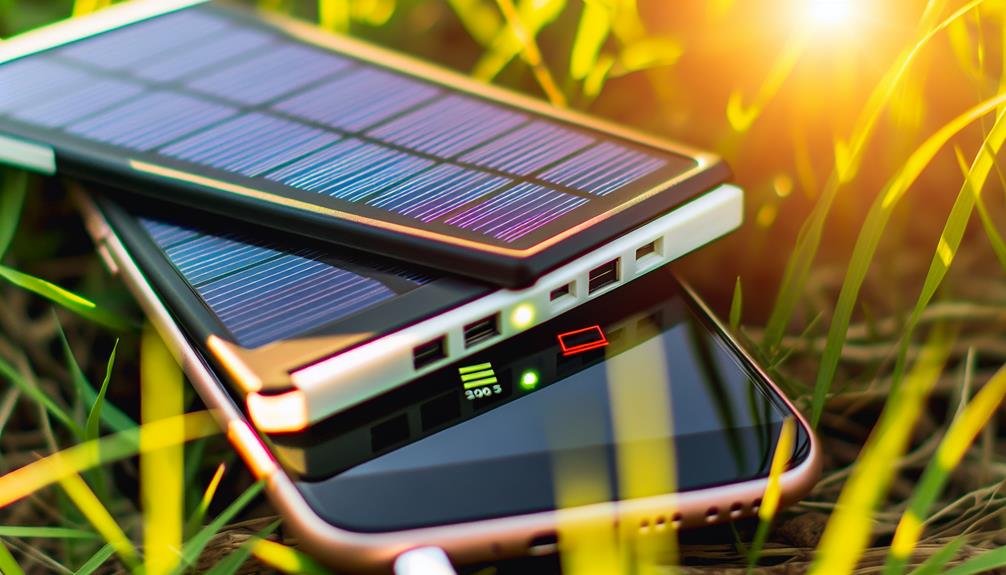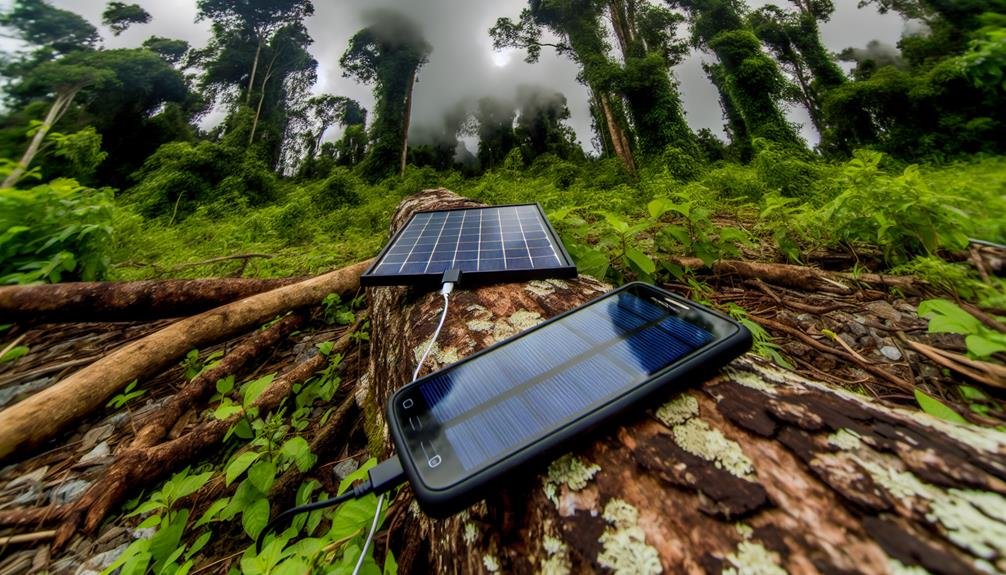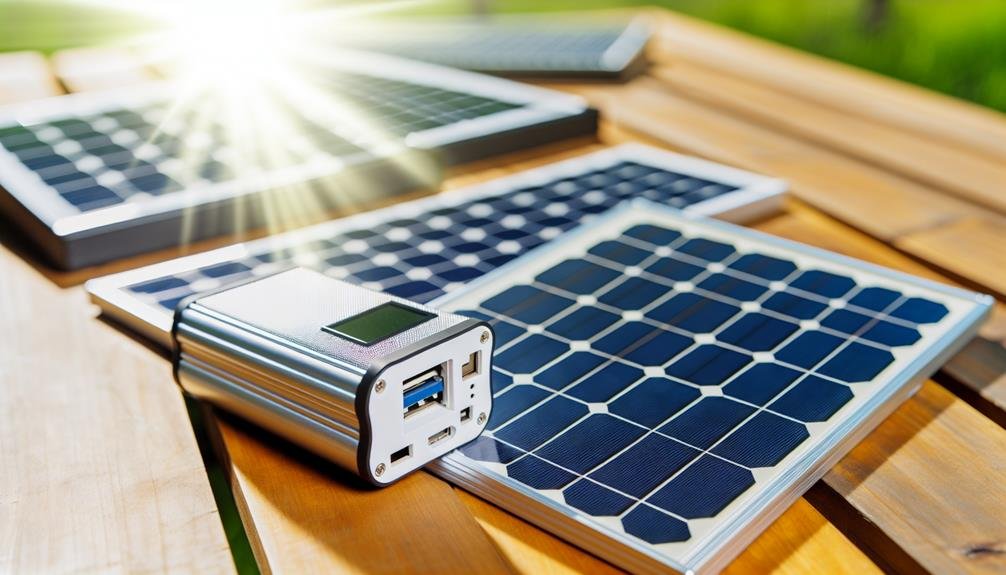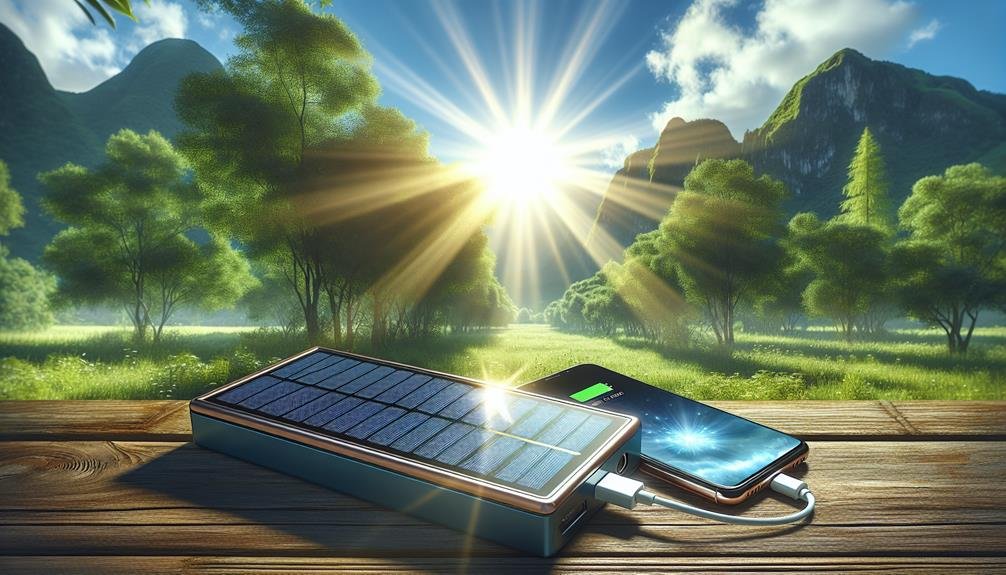Solar panel power banks convert sunlight into electrical energy via photovoltaic cells, stored in an internal battery measured in mAh. They're eco-friendly, reduce fossil fuel reliance, and are ideal for outdoor use. However, their capacity is usually lower, and they charge slower than traditional power banks, especially in less sunny conditions. Their initial cost is higher, but long-term savings on electricity and reduced carbon emissions can offset this. High-quality models with good durability, capacity, and efficiency offer the best value. Understanding these factors will guide you on whether they're the right fit for your needs.
How Solar Power Banks Work

Essentially, solar power banks transform sunlight into electrical energy through photovoltaic cells, which you can then use to charge your devices. These cells, often made from silicon, absorb photons from sunlight, knocking electrons loose and creating a flow of electricity. This direct current (DC) is then stored in the bank's internal battery, ready for when you need it. The energy stored is typically measured in milliampere-hours (mAh), indicating how much charge it can hold.
The use of renewable energy sources like solar power banks greatly reduces your environmental impact. Unlike traditional power banks, which rely on electricity from fossil fuels, solar power banks harness the sun's energy—a clean, abundant, and renewable resource. This process eliminates greenhouse gas emissions associated with conventional electricity generation, contributing to a decrease in your carbon footprint.
To ensure safety, many solar power banks incorporate overcharge protection, short-circuit prevention, and temperature control mechanisms. These features guarantee that your devices and the power bank itself remain safe during use. By understanding how solar power banks work, you can make informed decisions about integrating renewable energy into your daily life, promoting both safety and environmental sustainability.
Benefits of Solar Power Banks
Harnessing the power of the sun, solar power banks offer an environmentally friendly and cost-effective solution for charging your devices on the go. These portable chargers provide numerous benefits that make them highly appealing, particularly for those who value environmental impact and convenience.
First, by utilizing renewable solar energy, these devices reduce carbon footprints, making a positive environmental impact. They don't rely on grid electricity, which is often generated from fossil fuels, thereby lowering greenhouse gas emissions.
Second, the energy efficiency of solar power banks ensures that you can harness solar energy effectively. Modern solar panels convert sunlight into electrical energy with impressive efficiency rates, which translates to faster charging times for your devices.
Third, their portability makes them an excellent choice for outdoor activities, travel, and emergency preparedness. Lightweight and often compact, solar power banks can be easily carried in a backpack or even a pocket, guaranteeing you have a reliable power source wherever you go.
- Environmentally Friendly Charging: Reduces reliance on fossil fuels.
- Energy Efficient: Fast and efficient energy conversion.
- Portable: Convenient for travel, outdoor use, and emergencies.
These benefits make solar power banks a smart, sustainable choice for today's tech-savvy and environmentally conscious consumers.
Limitations to Consider

While solar power banks offer numerous benefits, it's crucial to recognize their limitations to ensure you make an informed decision. One significant limitation is battery capacity. Most solar power banks have a smaller battery capacity compared to traditional power banks, typically ranging between 10,000mAh to 20,000mAh. This means they might not fully charge larger devices such as tablets or laptops.
Another important factor is charging speed. Solar panels on these power banks usually have a lower wattage, often between 5 to 15 watts. As a result, the charging process can be considerably slower compared to plugging into a conventional electrical outlet. For example, under optimal sunlight conditions, it could take several hours to charge a smartphone fully and even longer for larger devices. This slow charging speed can be inconvenient if you need a quick power boost.
Additionally, environmental conditions play a significant role. Solar power banks rely on sunlight, making them less effective in cloudy or indoor settings. Regular exposure to the elements can also wear down the solar panels over time, impacting long-term efficiency. Hence, while solar power banks offer eco-friendly and portable energy solutions, these limitations should be carefully considered for safe and effective use.
Comparing Costs and Savings
When comparing the costs and savings of solar panel power banks, it's vital to analyze both the initial investment and the long-term financial benefits they offer. Conducting a thorough financial analysis is crucial to determine if the upfront cost is justified by the potential savings over time.
Consider these factors:
- Initial Cost vs. Lifetime Savings: The initial price of a solar panel power bank can be higher than traditional power banks. However, the energy efficiency and savings on electricity bills can offset this cost in the long run.
- Environmental Impact: Solar panel power banks contribute to reduced carbon emissions, which might not have a direct financial return but offers significant environmental benefits.
- Durability and Maintenance: High-quality solar panel power banks often require minimal maintenance and have a longer lifespan, making them a sound long-term investment.
Choosing the Right Model

Selecting the best solar panel power bank model requires a detailed evaluation of key specifications such as battery capacity, solar panel efficiency, and portability. First, assess the battery capacity, typically measured in milliamp-hours (mAh). Higher capacity provides more charges but often adds weight. For instance, a 20,000 mAh power bank can charge a smartphone multiple times but may compromise portability.
Durability is another vital factor. Look for models with rugged designs, water resistance, and protective features to ensure long-lasting performance. A durable power bank will withstand outdoor conditions, making it a reliable companion for camping or hiking trips.
Portability is essential if you plan to carry the power bank frequently. Smaller, lightweight models are easier to transport but may offer reduced battery capacity and charging speed. Evaluate the trade-offs based on your specific needs.
Charging speed is important for efficiency. Some models feature fast-charging technology, significantly reducing the time needed to recharge devices. Check for USB-C or Quick Charge capabilities, which can enhance charging speed.
Frequently Asked Questions
Can Solar Power Banks Charge Multiple Devices Simultaneously?
Yes, solar power banks can charge multiple devices simultaneously. However, watch for compatibility issues and charging capacity. Portability and efficiency vary, so confirm the model you choose meets your devices' needs for reliable and safe charging.
How Long Do Solar Power Banks Typically Last?
When it comes to solar power bank lifespan, they typically last 3-5 years. Solar power bank durability depends on usage and maintenance, so treating them with care guarantees they don't kick the bucket prematurely, maintaining safety and efficiency.
Are Solar Power Banks Waterproof or Weather-Resistant?
Solar power banks often include durability features such as waterproof or weather-resistant designs. However, these features can sometimes impact charging efficiency. Always check the product specifications to guarantee it meets your safety and performance requirements.
Do Solar Power Banks Require Direct Sunlight to Charge?
Did you know 30% of solar power banks can charge indoors under strong artificial light? However, for best battery capacity, direct sunlight is ideal. Indoor charging is possible but slower, ensuring your device is always safe.
What Maintenance Do Solar Power Banks Need?
You've got to guarantee regular cleaning of the solar panels to optimize efficiency. Battery replacement is essential after several years, depending on usage. Proper maintenance guarantees safety and prolongs the lifespan of your solar power bank.



